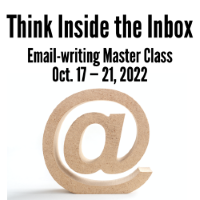Sensus goes to the science museum
When I teach the feature-style story structure, communicators nod. It seems reasonable that readers would prefer concrete, creative stories to a hierarchical blurtation of facts.

BUT — and as Pee-Wee Herman said, there’s always a big but — they wonder, is the feature-style story structure for everything? Even for writing an email? Even for writing event invites?
Yes, Virginia, the feature structure works for almost everything — email messages included, event invites include. And here’s proof, thanks to Sarah Herr, employee communications manager at Sensus.
In my Think Inside the Inbox workshop, Sarah rewrote her company’s holiday party invitation, transforming it from blah to brilliant, using the feature structure. Here’s how she did it:
1. Lead
The job of the lead is to grab readers’ attention and draw them in. But too often, writers get down to the nuts and bolts in email invitations.
Here’s Sarah’s original just-the-facts-ma’am approach:
But the key to a good invitation lead is to make folks want to attend the event. So tell them what they can look forward to in a concrete, creative, provocative feature lead.
Sarah visited my BFF and research assistant, Google, to find out what her colleagues could do at the science museum. Her revision whets my appetite with specific details about the party:
Remember, you’re covering the topic in the subject line. If you mention the holiday party there, you don’t need to lead with it.
2. Nut graph
In the nut graph, you’ll tell readers where you’re taking them.
Inverted pyramids don’t include nut graphs, so Sarah’s original email invitation skipped this element too. But in her revised piece, Sarah encapsulates the main point in one quick, informal sentence:
3. Background
The background section gives readers information they need to know before they dive into the body of the story. That might be a definition, bit of context or history lesson.
But background is also known as blah-blah. Don’t let blah-blah get between your readers and your story: Keep this to one short paragraph.
In her first version, Sarah has a quick paragraph of background after the lead:
Her revision pares that down a bit:
4. Body
The body is where you develop the story. In this case of an email invitation, you’ll give a few more details about what people will be able to see, learn or do at the event.
Sarah’s original was already pretty good. She had me at heavy hors d’oeuvres and carving stations!
In the revision, she adds a few more details about what attendees will be able to see and do:
If you have a series of three or more activities to showcase, you might use bullet points to make the body a list. The line breaks and extra white space make these activities stand out.
5. Wrapup
In the wrapup, you’ll draw to a conclusion.
Your call to action goes here. That means the wrapup — not the lead — is where you put time, date, place, contact information and the reserve button. Something like:
6. Kicker
The job of the kicker is to end with a bang, to leave a lasting impression. Inverted pyramids don’t include kickers, so Sarah’s original doesn’t, either. But in her revision, she ends with a bang in a concrete, creative provocative final paragraph:
Now that sounds like a party!
Congratulations, Sarah, on a great email!
How to structure an email invitation
The feature structure increases reading, sharing and more. (Download our free e-book chapter on why the feature outperforms the inverted pyramid.)
For that reason, features work for virtually all media, channels, topics and audiences. Choose this structure when you write a formal email, professional email or business email, as well as an email invitation. It’s also a good idea to use a feature approach for social media and other business communications. Next time you find yourself composing an email invitation, double-check this list before sending the email.
Learn more about writing emails:
- What email address should you use?
- How can you write a compelling subject line?
- How else can you make your email programs more effective?
How can you get the word out via email?
Email recipients spend an average of just 11 seconds on marketing emails they review. They spend just 51 seconds on email newsletters.
In this environment, how do you get the word out via email? 
Find out at Think Inside the Inbox — our email-writing workshop on Oct. 17.
You’ll learn how to make your email message short — but not too short, how to write paragraphs that get read on smartphones, and how to hit the right readability level for email.
You’ll leave with tips, tricks, latest best practices — and the data to back it all up — for getting your email newsletters and marketing pieces opened and read.
Save up to $100 with our group discounts.
